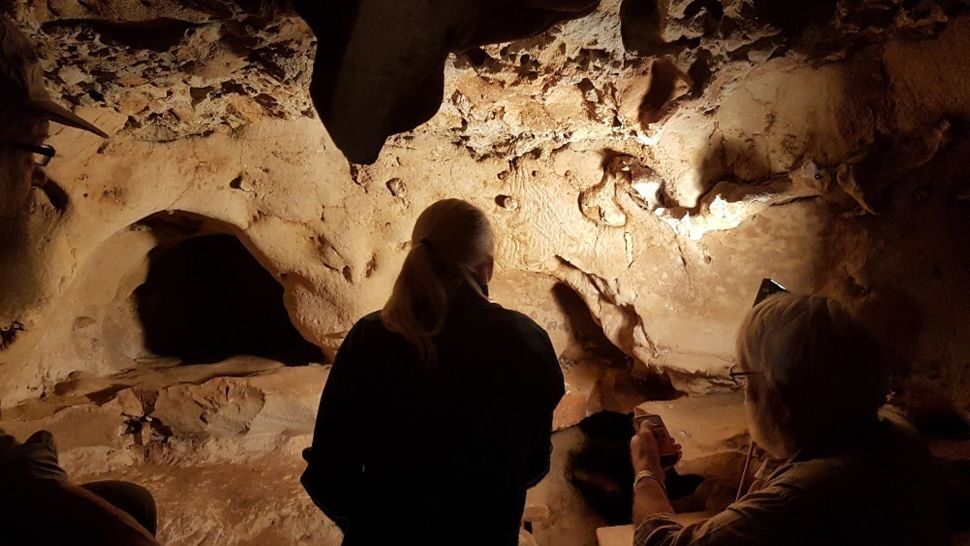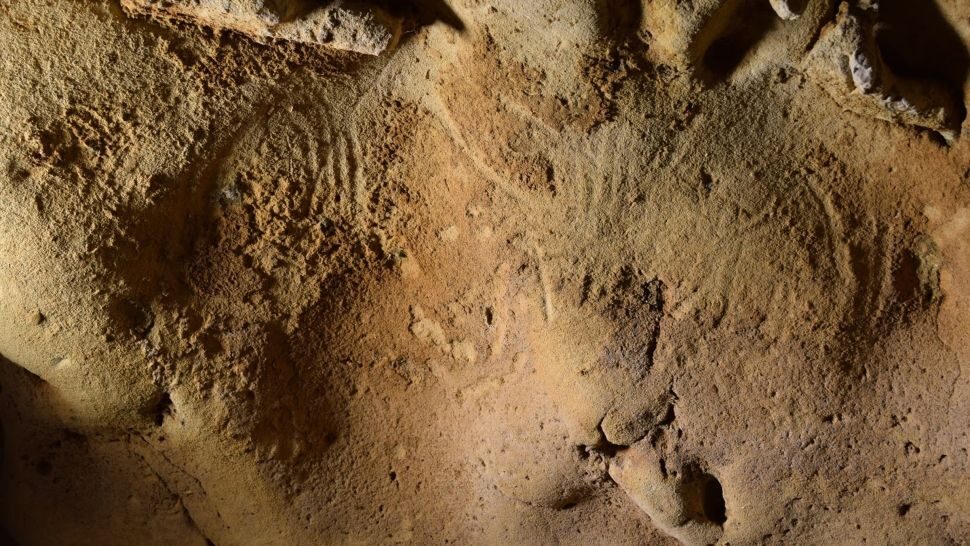
Within the cave of La Roche-Cotard 150 miles (240 kilometers) southwest of Paris, the researchers analyzed a series of non-figurative markings thought to be made by ancient human fingers, according to a study published Wednesday (June 21) in the journal PLOS One.
The cave had been sealed up by sediments until the late 19th century. Modern excavations at the site have yielded numerous stone tools whose style is associated with the Neanderthals, suggesting they created the art.
Ancient figurative art, including wall paintings, is well-known from European sites, with drawings of horses, lions and handprints representing famous examples of Upper Paleolithic culture dating back 35,000 years. For decades, researchers thought that these creations were hallmarks of modern human behavior, but recently, researchers have unearthed older examples of non-utilitarian objects and art in Europe and in other areas of the world, such as a 51,000-year-old chevron-engraved bone in Germany created by Neanderthals; however, Homo sapiens are credited with a 45,500-year-old drawing of a warty pig in Indonesia and a 73,000-year-old hashtag drawing in South Africa.

To figure out how the engravings were made, the researchers set up an experiment at a similar cave, in which one person created marks using their fingers, bone, wood, antler, flint and metal points against the rock wall. Another person then recorded what those marks looked like and used photogrammetry methods — a technique that uses hundreds of photos to create virtual 3D models — to compare the experimental marks with the prehistoric ones.
The researchers concluded that the experimental finger markings were most similar to the prehistoric engravings.
The researchers also found no direct link between the numerous stone tools discovered in the cave and the engravings, further supporting the finding that Neanderthals created the engravings with their fingers, just as the researchers did. For the most part, the engravings on the cave wall are lines called "finger flutings," made when someone swiped their fingers flat along the silt-covered wall, the team concluded.
To further refine the date the cave was used and figure out if the finger flutings were those of modern humans or Neanderthals, the researchers used optically stimulated luminescence of the sediments to determine when they were last exposed to daylight. The analysis revealed that the cave closed up at least 57,000 years ago and possibly as long as 75,000 years ago.
These early dates mean it's "highly unlikely" that anatomically modern humans had access to the inside of the cave, the researchers wrote in their study, as current evidence suggests they were not present in France until at least 54,000 years ago, whereas Neandertals appeared there around 330,000 years ago. "We conclude that the LRC engravings are unambiguous examples of Neanderthal abstract design," they wrote.
April Nowell, a paleolithic archaeologist at the University of Victoria in Canada who was not involved in this study, told Live Science in an email that "this study is important because it extends the antiquity of digital [finger] tracings and, for the first time, associates them with a hominin species other than Homo sapiens."
But the significance of these engravings remains unclear. "Although the finger tracings at La Roche-Cotard are clearly intentional," the researchers wrote, "it is not possible for us to establish if they represent symbolic thinking."
Nowell agreed that "these tracings do not have to be symbolic any more than when someone traces their fingers in the sand on a beach." The engravings are, however, important new information about the behavior of our Neanderthal relatives, whose culture was more complex and diverse than previously realized.



Ah, it would have been interesting if there were more. The assumption is that Neanderthals could not make enough associations for symbolism or for a complex social structure. They could take care of immediate family fairly well (but could not ameliorate the suffering of distant relatives?), imitate and do things by rote, and had an arduous existence defined by suffering.
A moderately authoritarian society is that which cares about widespread suffering enough to ameliorate it, and on the conservative side it hopes to curb widespread evil. Dementia and mental illness fall under both suffering and evil. Sapiens came up with religion and eventually government to solve these issues; I wonder if Neanderthals were incapable of having anything analogous, and whether dementia is even applicable to them.